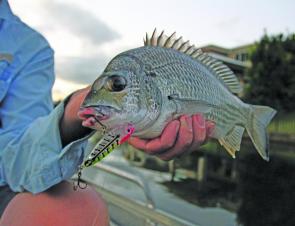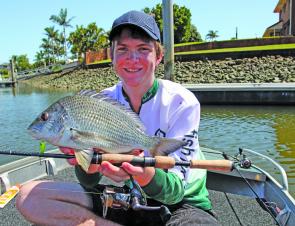A lot has been happening in Moreton Bay lately. In the wake of January’s floods and now with the six week snapper closure until 31 March, many anglers are a bit unsure as what to chase out on the water.
The good news is that Autumn is traditionally one of the best times to fish in South East Queensland. There are stacks of options, from longtails and mac tunas in the open parts of the bay, to bream, flathead and sweetlip in the shallows of the islands or foreshores. In creeks and canals good catches of bream, cod and jacks are possible and trevallies and kingfish available around rock walls and jetties.
Light tackle lure fishing around the shallows would have to rate as one of the most fun ways to spend a few hours on the Bay. A rising tide is the most popular time to fish in the shallows, particularly with surface lures, but there are options for the falling tide especially for chasing flathead. On the sandy flats, flathead bream and whiting are the main targets.
Shallow running lures like little Maria and Jackall crankbaits are ideal on the rising tide as they can be cast a fair distance and have a big appeal for the bream and flathead. Skinny little minnows like the Maria jerkbaits can also appeal to the whiting and the narrow profile makes it easier to get a hook-up on the smaller mouthed species.
In the real skinny water, particularly near weed beds, whiting are suckers for small fast rapidly moving poppers and stickbaits. Some good ones to try include Sebile 52mm Splashers and Lucky Craft Bevy Props.
Clear and neutral baitfish colours work very well on the whiting though many anglers do like a splash of pink or orange on their whiting lures.
Once the tide starts to run out around the sand flats, flathead really come into their own. Some big whiting and bream can be caught on the falling tide too but there tend to be less fish than during the rising tide.
For the flathead, a 3-4” long soft plastic such as an Assassin paddle tail or Gulp curl tail grub is ideal. Use a jighead with enough weight to cast a reasonable distance and stay down near the bottom where the flathead are. This could be anywhere from about 3-10g, depending on the depth and the lure. Flicking and hopping the plastic along the bottom with short pauses in between is a good way to get a flatheads attention.
Many of the shorelines of the southern bay are strewn with rock and coral, while the canal systems at Raby Bay and Aquatic Paradise are full of rocks and other man-made structures. As well as the previously mentioned bream and flathead, these areas also house hard pulling species such as mangrove jacks, cod and trevally.
On the rising tide over shallow rocks and reef, surface lures really come into their own. They don’t get snagged on the rough bottom allowing the angler to cast their lures into places that would appear to be too shallow to hold fish. It is common for a bream, cod or jack to come rocketing out to clobber a lure in water so shallow, they ought to be swimming on their sides!
As the tide nears full and much of the rocky structure is under 1m of water, then it is usually time to go back to a diving lure to get right down in front of the fish.
In the canals there is generally a lot more depth to explore than up on the flats, so often the surface lures take a back seat to the deep diving varieties. 40-75mm long deep divers are great for working down the walls.
The long bibs are great to help avoid snags: when you feel the bib hit a rock, just pause and let the lure float off a little way before recommencing the retrieve. Mangrove jacks and cod often make their attack at the moment of the pause, so always be ready for that jarring strike.
Shallow running and surface lures still get a good run here too, either for working around structures such as pontoons and moored boats or for prospecting the open channel mouths for trevally and the odd giant herring or queenfish.
Lastly, but definitely not least of all, March is generally when longtail tuna activity really takes off in Moreton Bay. Chasing tuna schools successfully is an art form well worth mastering, as it can lead to the capture of a blue torpedo, weighing 10-15kg and sometimes a whole lot more.
Early in the season, longtails can be quite frustrating, busting up here, there and everywhere; sometimes they seem to appear everywhere except for where you are. In these instances the best method is to stop trying to chase the tuna and just drift in an area where they are working.
Jigging 5-7” soft plastics, floating a live bait or even drifting a pillie can work really well in this situation. Another technique is to cast a skipping style popper around to imitate a fleeing garfish: some days this can draw crashing strikes from all over the paddock when other approaches have been completely ignored.
Until next month, tight lines! If you would like more information about fishing the southern bay, just drop in and see us at Fish Head in the Victoria Point Town Centre (just across the car park from McDonalds) or send an email to --e-mail address hidden--
1
Trevally are great fun in the estuaries in March.
2
Maria lures have been proving successful on the bream in the canals.
3
Bream will be one of the best species to target this month.
Reads: 2997






